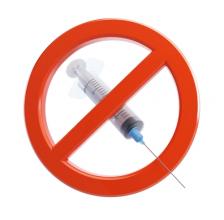The No-Needle, No-Scalpel Vasectomy
Learn about the new low-risk method in permanent male sterilization. No needles, little pain, and fast recovery. Find out more.
Sanaz Majd, MD
Listen
The No-Needle, No-Scalpel Vasectomy

Birth control is one of the most common topics discussed at the doctor’s office. It’s important to learn your options and the pros and cons of each to determine what’s right for you.
A good percentage of my patients know they no longer want any more children. In that case, there are two options for permanent sterilization: a tubal ligation for the female or a vasectomy for the male. And the risks/benefits of these two options are quite different. A tubal is done under general anesthesia in the hospital, with a week-long recovery period.
A vasectomy is a quick office procedure with only 1-2 days of recovery. And even though the vasectomy is an efficient, low-risk method that is considered to be the most effective method of birth control out there, many men shy away from it. Why? I see a lot of men who say that they would consider a vasectomy were it not for the pain. They just can’t stand the thought of pain in the most sensitive and intimate part of their body.
So today I wanted to invite a guest, Dr. Edward Ferrer, a family medicine physician who performs vasectomies in the city of San Diego. Dr. Ferrer will not only give us the real scoop on the vasectomy procedure to help dispel some of these myths and fears, but he’ll also discuss a new technique that may change the minds of fearful men secretly wishing to get it done, but terrified of this procedure.
Men, this new method may just change your minds!
Q: What is a vasectomy exactly?
A vasectomy is a male sterilization procedure in which the “vas deferens” (the small tube that carries the sperm from the testes) is snipped. Hence in the term “vasectomy,” the “vas” refers to “vas deferens” and “-ectomy” means “to cut.” Sperm is no longer carried out once this cut is made; however, semen is still ejaculated. If sperm is not present in semen, an ovulated egg can no longer be fertilized.
Q: What is the “No-Needle, No-Scalpel Vasectomy” and how is it different from the regular procedure?
Traditionally, vasectomies are performed using a needle to anesthetize and a scalpel cut through the skin. This is the reason most men shy away from this procedure, for fear of sharp objects and pain. However, with the “No-Needle, No-Scalpel vasectomy,” like the name suggests, there are no needles or scalpels used. Instead, a special device uses a high-pressure stream of anesthetic to penetrate through the skin, and an instrument called a “dissector” is used to spread open the skin. Then, the vas is severed using “thermo-cautery,” which is a device with a heated metallic tip, rather than a sharp scalpel. A small titanium clip is used to close the vas sheath around the lower end so that the ends are separated by a tissue layer and less likely to grow back together. So there’s no cutting and therefore, no stitches. The small opening is often closed by the following day.
I know what you’re thinking — no, the clip won’t set off airport alarms and your scrotum won’t explode in an MRI machine.
Q: How long does the procedure and recovery take?
This is an office procedure that takes approximately 20 minutes to complete. There is typically some minor discomfort and swelling at the site for 2-3 days after the procedure, but most men are back to their baseline within a week. A jock strap is typically worn for the first four days and then only during exercise for one month. Condoms are advised for 12 weeks after the procedure to assure that all sperm has been ejaculated. The last thing you’d want is to get pregnant after finally going through with the vasectomy procedure, but with this left-over sperm that just didn’t swim out in time.
Q: What are the risks?
Large-scale studies show that the overall incidence of complications is less than 5 per 100 vasectomies performed. Some of the most common risks associated with the vasectomy are bruising, tenderness, swelling, infection, and bleeding. Some men (about 1 in 20) will experience swelling and a mild ache in one or both testes anywhere from 2 weeks to 6 months after the procedure. Overall incidence of either a hematoma (a blood clot in the scrotum) or infection is less than 2% of the vasectomies performed. Another risk is post-vasectomy pain syndrome, which is a rare condition that produces chronic testicular pain for greater than 3 months after having a vasectomy, and occurs in 1-2% of vasectomies. Sterilization failure rate is less than 1%, as well. However, most men do very well and the risks and complications from this technique are quite low.
Q: And the question every man wants to know…Is there pain?
More than anything, there’s really only some discomfort, not pain. And it’s much more tolerable than the traditional vasectomy method. My method is often compared to a rubber band snap as the anesthetic is injected. After the injection, patients do not feel any pain during the rest of the procedure, only some minor pressure. Let’s face it, it’s far less than the pain of your spouse’s tubal ligation – or childbirth!
Q: What are the advantages of this new technique?
-
It’s a quick office procedure that only takes 20 minutes. A tubal ligation, on the other hand, is typically done under general anesthesia in the hospital with a longer recovery.
-
No needle and no scalpel mean less pain.
-
The risks of complications are much lower as compared to the traditional vasectomy procedure.
-
It’s more cost-effective than other birth control options, including tubal ligation.
-
A vasectomy is the most effective form of birth control, with less than 1% risk of failure.
Q: Will it affect sex drive?
There is absolutely no evidence that a vasectomy will change your sex-drive or performance, affect your sex hormone levels, or cause erectile dysfunction. Those are all myths.
Q: Is it reversible?
You should consider a vasectomy to be permanent and non-reversible. There are surgical procedures to help reverse a vasectomy, but the success is variable and not guaranteed. Vasectomy reversal is a three-hour surgery that results in return of sperm to the semen about 85% of the time. Success rates decrease with time after vasectomy. If you are going to consider a vasectomy, it’s best to assume that it’s a permanent change. Do not get a vasectomy if you have any doubts whatsoever.
Q: What is the typical cost?
Costs can range anywhere from $400 to $1,200, but the procedure is often a covered medical benefit through your insurance. At the Vasectomy Clinic of San Diego the cost out of pocket for those without vasectomy coverage, without insurance, or for those whose physicians do not perform this new technique is just a flat $500 fee. This fee covers your consultation visit, the procedure, and any post-procedure follow up.
Q: How can patients learn more about this new vasectomy technique?
Patients can check out my website VasectomyClinicSanDiego.com for more information, or feel free to email me at info@vasectomyclinicsadiego.comcreate new email.
Don’t forget to join the House Call Doctor’s Facebook and Twitter pages, where you can read more of my health related tips.
No Needle image care of Shutterstock

